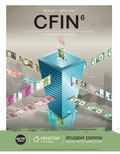
MyLab Finance with Pearson eText -- Access Card -- for Principles of Managerial Finance
15th Edition
ISBN: 9780134479903
Author: Chad J. Zutter, Scott B. Smart
Publisher: PEARSON
expand_more
expand_more
format_list_bulleted
Question
Chapter 5, Problem 5.5P
Sub part (a)
Summary Introduction
To calculate:
Introduction:
Future value (FV): The future value refers the value of present amount at a future date.
Sub part (b)
Summary Introduction
To calculate: Interest earned.
Sub part (c)
Summary Introduction
To discuss: Comparison of future value in and interest earned.
Expert Solution & Answer
Want to see the full answer?
Check out a sample textbook solution
Students have asked these similar questions
Crenshaw, Incorporated, is considering the purchase of a $367,000 computer with an economic life of five years. The computer will be
fully depreciated over five years using the straight-line method. The market value of the computer will be $67,000 in five years. The
computer will replace five office employees whose combined annual salaries are $112,000. The machine will also immediately lower
the firm's required net working capital by $87,000. This amount of net working capital will need to be replaced once the machine is
sold. The corporate tax rate is 22 percent. The appropriate discount rate is 15 percent. Calculate the NPV of this project.
Note: Do not round intermediate calculations and round your answer to 2 decimal places, e.g., 32.16.
NPV
Answer is complete but not entirely correct.
S 103,141.80
Your firm is contemplating the purchase of a new $610,000 computer-based order entry system. The system will be depreciated
straight-line to zero over its five-year life. It will be worth $66,000 at the end of that time. You will save $240,000 before taxes per year
in order processing costs, and you will be able to reduce working capital by $81,000 (this is a one-time reduction). If the tax rate is 21
percent, what is the IRR for this project?
Note: Do not round intermediate calculations and enter your answer as a percent rounded to 2 decimal places, e.g., 32.16.
IRR
%
QUESTION 1
Examine the information provided below and answer the following question.
(10 MARKS)
The hockey stick model of start-up financing, illustrated by the diagram below, has received a lot of attention in the
entrepreneurial finance literature (Cumming & Johan, 2013; Kaplan & Strömberg, 2014; Gompers & Lerner, 2020). The model
is often used to describe the typical funding and growth trajectory of many startups. The model emphasizes three main
stages, each of which reflects a different phase of growth, risk, and funding expectations.
Entrepreneur, 3 F's
Debt(banks & microfinance)
Research Business angels/Angel Venture funds/Venture capitalists
Merger, Acquisition
Grants
investors
PO
Public market
Growth (revenue)
Break even
point
Pide
1st round
Expansion
2nd round
3rd round
Research
commercial idea
Pre-seed
Initial concept
Seed
Early
Expansion
Financial stage
Late
IPO
Inception and
prototype
Figure 1. The hockey stick model of start-up financing (Lasrado & Lugmayr, 2013)
REQUIRED:…
Chapter 5 Solutions
MyLab Finance with Pearson eText -- Access Card -- for Principles of Managerial Finance
Ch. 5.1 - What is the difference between future value and...Ch. 5.1 - Define and differentiate among the three basic...Ch. 5.2 - Prob. 5.3RQCh. 5.2 - Prob. 5.4RQCh. 5.2 - Prob. 5.5RQCh. 5.2 - Prob. 5.6RQCh. 5.2 - Prob. 5.7RQCh. 5.3 - What is the difference between an ordinary annuity...Ch. 5.3 - What are the most efficient ways to calculate the...Ch. 5.3 - How can the formula for the future value of an...
Ch. 5.3 - Prob. 5.13RQCh. 5.3 - What is a perpetuity? Why is the present value of...Ch. 5.4 - How do you calculate the future value of a mixed...Ch. 5.5 - What effect does compounding interest more...Ch. 5.5 - Prob. 5.21RQCh. 5.5 - Differentiate between a nominal annual rate and an...Ch. 5.6 - How can you determine the size of the equal,...Ch. 5.6 - Prob. 5.27RQCh. 5.6 - How can you determine the unknown number of...Ch. 5 - Learning Goals 2, 5 ST5-1 Future values for...Ch. 5 - Learning Goal 3 ST5-2 Future values of annuities...Ch. 5 - Prob. 5.3STPCh. 5 - Learning Goal 6 ST5-4 Deposits needed to...Ch. 5 - Assume that a firm makes a 2,500 deposit into a...Ch. 5 - Prob. 5.2WUECh. 5 - Prob. 5.3WUECh. 5 - Your firm has the option of making an investment...Ch. 5 - Joseph is a friend of yours. He has plenty of...Ch. 5 - Jack and Jill have just had their first child. If...Ch. 5 - Prob. 5.1PCh. 5 - Learning Goal 2 P5-2 Future value calculation...Ch. 5 - Prob. 5.4PCh. 5 - Prob. 5.5PCh. 5 - Learning Goal 2 P5- 6 Time value As part of your...Ch. 5 - Learning Goal 2 P5-7 Time value you can deposit...Ch. 5 - Learning Goal 2 P5-8 Time value Misty needs to...Ch. 5 - Learning Goal 2 P5- 9 Single-payment loan...Ch. 5 - Prob. 5.10PCh. 5 - Prob. 5.11PCh. 5 - Prob. 5.12PCh. 5 - Prob. 5.13PCh. 5 - Time value An Iowa state savings bond can be...Ch. 5 - Time value and discount rates You just won a...Ch. 5 - Prob. 5.16PCh. 5 - Cash flow investment decision Tom Alexander has an...Ch. 5 - Learning Goal 2 P5-18 Calculating deposit needed...Ch. 5 - Future value of an annuity for each case in the...Ch. 5 - Present value of an annuity Consider the following...Ch. 5 - Learning Goal 3 P5-21 Time value: Annuities Marian...Ch. 5 - Learning Goal 3 P5-22 Retirement planning Hal...Ch. 5 - Learning Goal 3 P5-23 Value of a retirement...Ch. 5 - Learning Goal 2, 3 P5-25 Value of an annuity...Ch. 5 - Prob. 5.26PCh. 5 - Prob. 5.30PCh. 5 - Learning Goal 4 P5-31 Value of a single amount...Ch. 5 - Value of mixed streams Find the present value of...Ch. 5 - Prob. 5.33PCh. 5 - Prob. 5.34PCh. 5 - Prob. 5.36PCh. 5 - Prob. 5.37PCh. 5 - Changing compounding frequency Using annual,...Ch. 5 - Prob. 5.39PCh. 5 - Prob. 5.40PCh. 5 - Compounding frequency and time value You plan to...Ch. 5 - Learning Goals 3, 5 P5-42 Annuities and...Ch. 5 - Prob. 5.43PCh. 5 - Prob. 5.44PCh. 5 - Prob. 5.45PCh. 5 - Prob. 5.46PCh. 5 - Prob. 5.47PCh. 5 - Loan amortization schedule Joan Messineo borrowed...Ch. 5 - Prob. 5.49PCh. 5 - Prob. 5.50PCh. 5 - Prob. 5.52PCh. 5 - Prob. 5.53PCh. 5 - Prob. 5.54PCh. 5 - Prob. 5.55PCh. 5 - Prob. 5.56PCh. 5 - Prob. 5.57PCh. 5 - Number of years needed to acccumulate a future...Ch. 5 - Prob. 5.59PCh. 5 - Prob. 5.60PCh. 5 - Time to repay Installment loan Mia Saito wishes to...
Knowledge Booster
Similar questions
- critically discuss the hockey stick model of a start-up financing. In your response, explain the model and discibe its three main stages, highlighting the key characteristics of each stage in terms of growth, risk, and funding expectations.arrow_forwardSolve this problem please .arrow_forwardSolve this finance question.arrow_forward
- solve this question.Pat and Chris have identical interest-bearing bank accounts that pay them $15 interest per year. Pat leaves the $15 in the account each year, while Chris takes the $15 home to a jar and never spends any of it. After five years, who has more money?arrow_forwardWhat is corporate finance? explain all thingsarrow_forwardSolve this finance problem.arrow_forward
arrow_back_ios
SEE MORE QUESTIONS
arrow_forward_ios
Recommended textbooks for you
 Financial Accounting: The Impact on Decision Make...AccountingISBN:9781305654174Author:Gary A. Porter, Curtis L. NortonPublisher:Cengage Learning
Financial Accounting: The Impact on Decision Make...AccountingISBN:9781305654174Author:Gary A. Porter, Curtis L. NortonPublisher:Cengage Learning
 Cornerstones of Financial AccountingAccountingISBN:9781337690881Author:Jay Rich, Jeff JonesPublisher:Cengage LearningPrinciples of Accounting Volume 2AccountingISBN:9781947172609Author:OpenStaxPublisher:OpenStax College
Cornerstones of Financial AccountingAccountingISBN:9781337690881Author:Jay Rich, Jeff JonesPublisher:Cengage LearningPrinciples of Accounting Volume 2AccountingISBN:9781947172609Author:OpenStaxPublisher:OpenStax College


Financial Accounting: The Impact on Decision Make...
Accounting
ISBN:9781305654174
Author:Gary A. Porter, Curtis L. Norton
Publisher:Cengage Learning


Cornerstones of Financial Accounting
Accounting
ISBN:9781337690881
Author:Jay Rich, Jeff Jones
Publisher:Cengage Learning

Principles of Accounting Volume 2
Accounting
ISBN:9781947172609
Author:OpenStax
Publisher:OpenStax College
